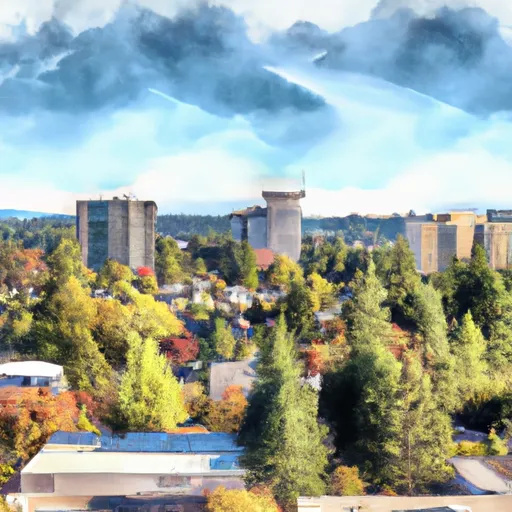-
 Snoflo Premium
Snoflo Premium
Get unlimited access to all our content
With no Ad interruptions! - Start Your Free Trial Login with existing account
Wilson-Creek
Eden Index
Climate
8.4
•
Recreation
2.3
•
Community
1.5
•
Safeguard
4.5/10

Wilson Creek is a small town located in Grant County, Washington. The region experiences a semi-arid climate, characterized by hot and dry summers, with temperatures often exceeding 90°F (32°C), and cold, occasionally snowy winters, with temperatures dropping below freezing. Precipitation is limited, averaging around 8 inches (20 cm) annually, and mainly falls during the winter months.
Hydrologically, Wilson Creek is situated near the creek of the same name, which flows through the town. The creek serves as an important water source for the region, supporting local agriculture and wildlife. It is fed by snowmelt from the nearby Cascade Mountains and contributes to the overall beauty of the area.
Outdoor recreation opportunities in Wilson Creek are abundant. The surrounding landscape offers opportunities for hiking, camping, and wildlife viewing. Nearby, the Columbia River provides a variety of water-based activities, such as boating, fishing, and swimming. The region is also known for its bird watching, with a variety of migratory and resident species found in the area. Overall, Wilson Creek offers a picturesque setting for outdoor enthusiasts to explore and enjoy nature.
What is the Eden Index?
The Snoflo Eden Index serves as a comprehensive rating system for regions, evaluating their desirability through a holistic assessment of climate health, outdoor recreation opportunities, and natural disaster risk, acknowledging the profound impact of these factors on livability and well-being.
Climate Health Indicator (CHI): 8.4
Wilson-Creek receives approximately
252mm of rain per year,
with humidity levels near 64%
and air temperatures averaging around
10°C.
Wilson-Creek has a plant hardyness factor of
6, meaning
plants and agriculture in this region thrive during a short period during spring and early summer. Most
plants will die off during the colder winter months.
By considering the ideal temperature range, reliable water supplies, clean air, and stable seasonal rain or snowpacks, the Climate Health Indicator (CHI) underscores the significance of a healthy climate as the foundation for quality living.
A healthy climate is paramount for ensuring a high quality of life and livability in a region, fostering both physical well-being and environmental harmony. This can be characterized by ideal temperatures, reliable access to water supplies, clean air, and consistent seasonal rain or snowpacks.
Weather Forecast
Streamflow Conditions
Upper Columbia
Area Rivers
Upper Columbia
Snowpack Depths
Upper Columbia
Reservoir Storage Capacity
Upper Columbia
Groundwater Levels
Recreational Opportunity Index (ROI): 2.3
The Recreational Opportunity Index (ROI) recognizes the value of outdoor recreational options, such as parks, hiking trails, camping sites, and fishing spots, while acknowledging that climate plays a pivotal role in ensuring the comfort and consistency of these experiences.
Access to outdoor recreational opportunities, encompassing activities such as parks, hiking, camping, and fishing, is crucial for overall well-being, and the climate plays a pivotal role in enabling and enhancing these experiences, ensuring that individuals can engage in nature-based activities comfortably and consistently.
Camping Areas
| Campground | Campsites | Reservations | Toilets | Showers | Elevation |
|---|---|---|---|---|---|
| Million Dollar North - WDFW | None | 1,604 ft | |||
| South Outlet - WDFW | None | 1,050 ft | |||
| Coulee City Community Park | None | 1,574 ft | |||
| Ankeny No. 1 - WDFW | None | 1,568 ft | |||
| Steamboat Rock State Park | 126 | 1,595 ft | |||
| Barker Canyon - WDFW | None | 1,582 ft | |||
| Moses Lake Dispersed | None | 1,053 ft |
Nearby Ski Areas
Catastrophe Safeguard Index (CSI):
The Catastrophe Safeguard Index (CSI) recognizes that natural disaster risk, encompassing floods, fires, hurricanes, and tornadoes, can drastically affect safety and the overall appeal of an area.
The level of natural disaster risk in a region significantly affects safety and the overall livability, with climate change amplifying these risks by potentially increasing the frequency and intensity of events like floods, fires, hurricanes, and tornadoes, thereby posing substantial challenges to community resilience and well-being.
Community Resilience Indicator (CRI): 1.5
The Community Resilience Indicator (CRI) recognizes that education, healthcare, and socioeconomics are crucial to the well-being of a region. The CRI acknowledges the profound impact of these elements on residents' overall quality of life. By evaluating educational resources, healthcare accessibility, and economic inclusivity, the index captures the essential aspects that contribute to a thriving community, fostering resident satisfaction, equity, and social cohesion.

